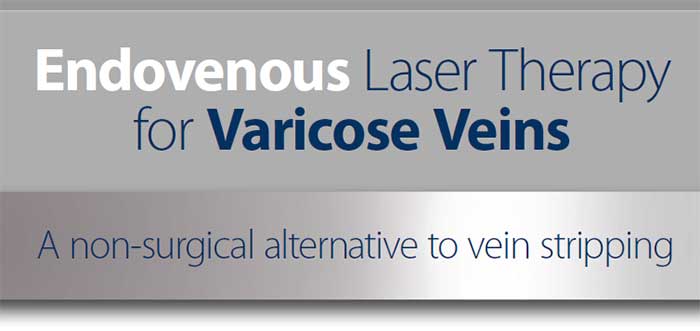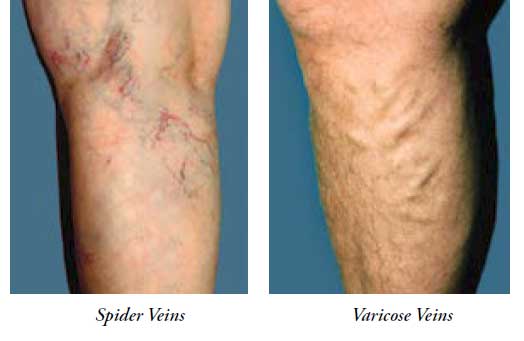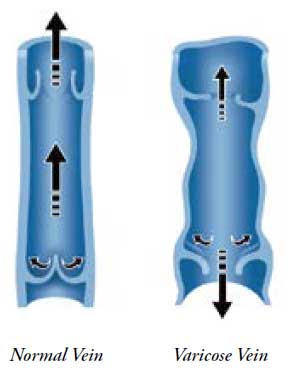Laser Therapy for Varicose Veins

Endovenous Laser Therapy
In the last few years, the use of lasers has become an accepted alternative to surgical stripping to treat varicose veins. In endovenous laser therapy, a thin laser fiber is inserted into the diseased vein, generally through a small puncture in the leg above where the visual symptoms appear. The physician then delivers laser energy through the fiber which causes the vein to close as the fiber is gradually removed. Endovenous laser therapy can be performed in a physician’s office in less than one hour, and the patient is encouraged to walk immediately following the procedure
How does endovenous laser therapy work?
Previously, treatment of painful, swollen varicose veins required a surgical procedure called vein stripping, where the vein was completely removed from the leg. More recently, endovenous laser therapy has been developed to treat chronic venous insufficiency by delivering laser energy through a small puncture in the leg to close the diseased vein.
With endovenous laser therapy, no surgery is required, and the entire procedure can be performed in less than one hour in your physician’s office. During the procedure, you are awake and your leg is anesthetized. A thin laser fiber is inserted into the greater saphenous vein in your thigh. Your physician then will deliver laser energy through the fiber and into the vein, causing the vein to close.
Is endovenous laser therapy painful?
Although individual responses vary, most people report little to no pain associated with endovenous laser therapy. Often the only sensation is felt during the delivery of anesthetic to the leg. After the procedure you may feel some tenderness, tingling, itching or tightness in the treated leg, which should disappear within a month.
How successful is endovenous laser therapy?
Clinical results have been published which document the success of endovenous laser treatment. Like any medical treatment, however, endovenous laser therapy has certain risks which your physician will explain to you as they apply to your individual case.
Q&A
Download the Endovenous Laser Therapy for Vericose Veins Q&A sheet to learn more!
What is vein disease?
Veins are the blood vessels that return blood to the heart from the body. To overcome the force of gravity, inside the veins are one-way valves which open to allow blood flow to the heart, and close to prevent “reflux” of blood back to the body. When these valves fail to function, or if the vein is damaged so the valves do not completely close, blood can begin to pool in the vein and cause a variety of vein complications.
What are the different types of vein disease?
Spider veins are the small, thread-like colored veins that are most often seen on the surface of the skin. While many people seek treatment for spider veins for cosmetic reasons, spider veins also can result in substantial discomfort requiring therapy. Varicose veins are the large, “rope-like” veins which are often ¼˝ or larger in diameter. Varicose veins generally grow in size over time and can result in substantial pain and complications if not treated.
How do I know if I have vein disease?
Fortunately, most vein disease can be seen by looking at the size and color of the vein at the skin surface. In some cases, however, the diseased vein may be deeper in the body and not visible through the skin. As a result, paying close attention to other symptoms is important in diagnosing vein disease. Many patients with vein disease experience cramping, aching, burning, itching, soreness or “tired” or “restless” legs, especially in the calf muscles. If you experience these symptoms, your physician can quickly and easily perform a test to determine if you have vein disease.
How common is vein disease?
Vein disease of the legs is one of the most common medical conditions. Approximately half of the population has some form of vein disease. Varicose veins affect between 15-25% of all adults, and approximately 50% of all people over age 50.1 Women have a higher incidence of vein disease than men.
How does vein disease occur?
The single most important cause of vein disease is heredity. Approximately 70% of all patients with varicose veins have parents with the same condition. Pregnancy, especially multiple pregnancies, is a contributing cause of vein disease. Other factors influencing vein disease are age, obesity and jobs which require long periods of standing.
Can vein disease be prevented?
Generally no. If you have a family history of vein disease, there is nothing you can do to change your genes. Being overweight can accelerate the progression of vein disease, and long periods of standing can also add to the problem. Diet and footwear are generally believed to be irrelevant in the formation of vein disease.


Specialties
Surgical Weight Loss
Abdominal Surgery
Complete Breast Care
Anti-Reflux (GERD) Surgery
Minimally Invasive Robotic Surgery
Laser Therapy for Varicose Veins
Hernia Surgery - Open and MIS
Cancer Surgery
Endoscopy
Venous Access
Ano-rectal Surgery
Thyroid and Parathyroid Surgery
Laparoscopic Sleeve Gastrectomy
Thibodaux Surgical Specialists
ABOUT TSS
With a genuine interest in each patient, we are dedicated to your best care.
We have carefully structured our practice to be able to provide the personal, quality care we feel you deserve.
SCHEDULE YOUR CONSULTATION
